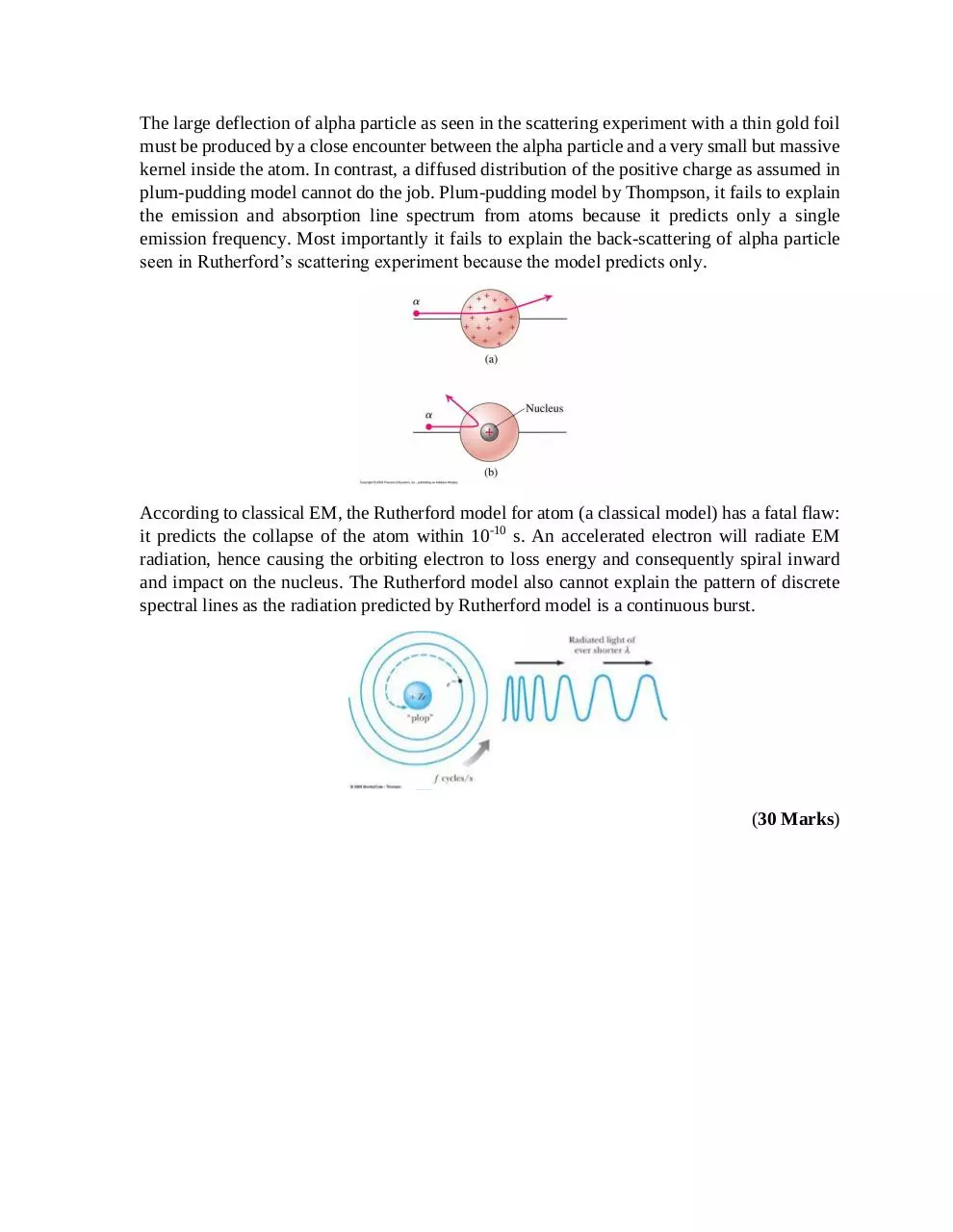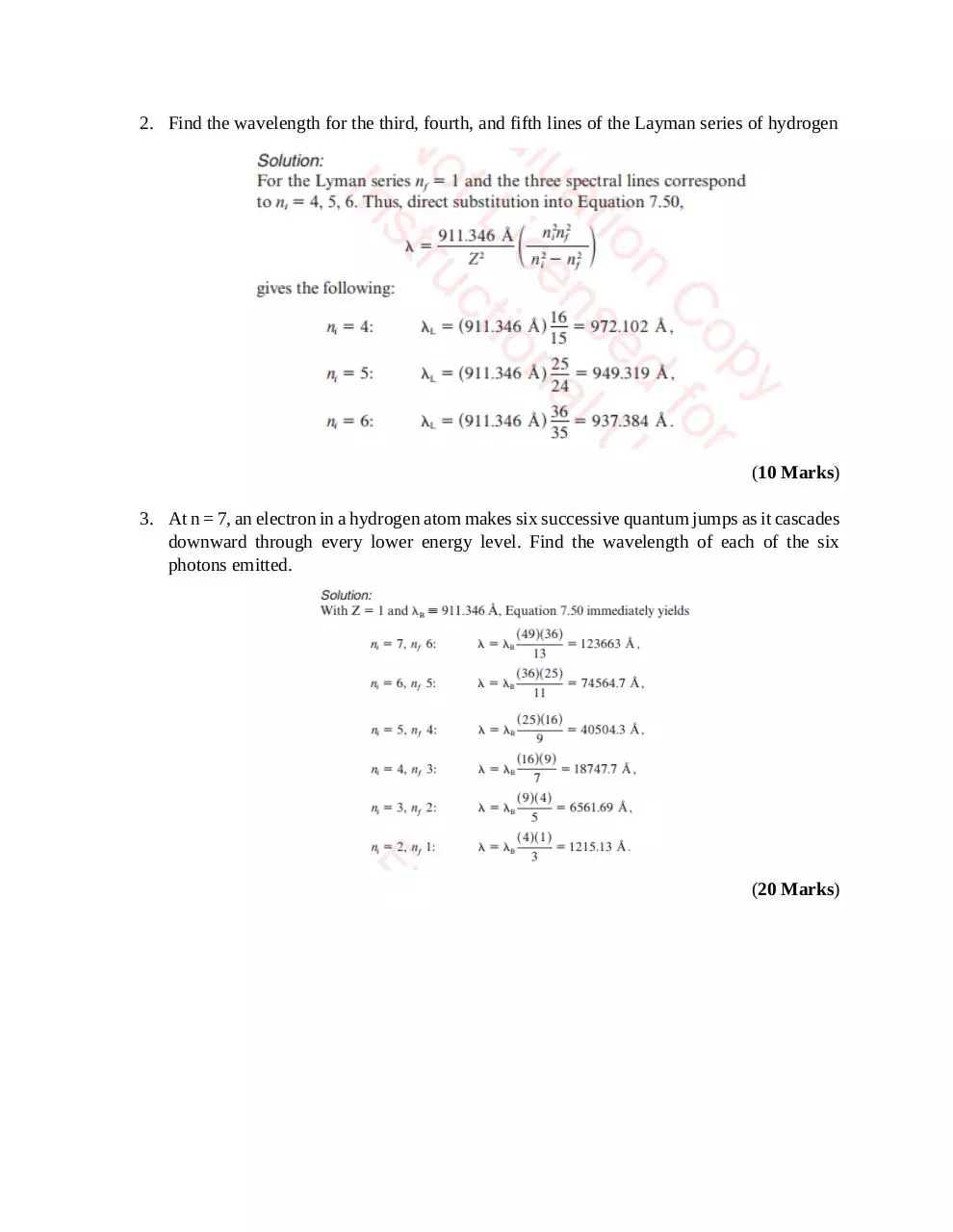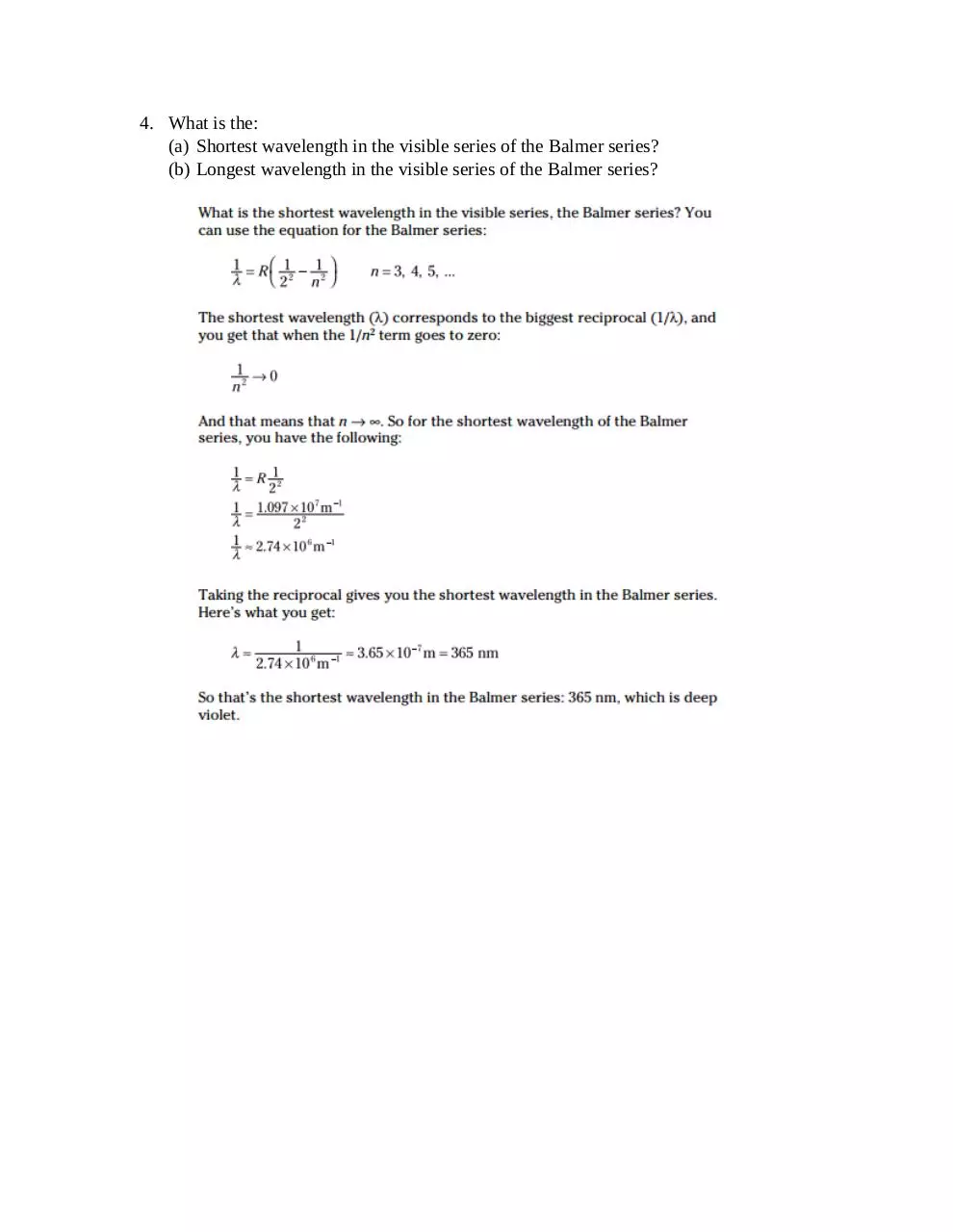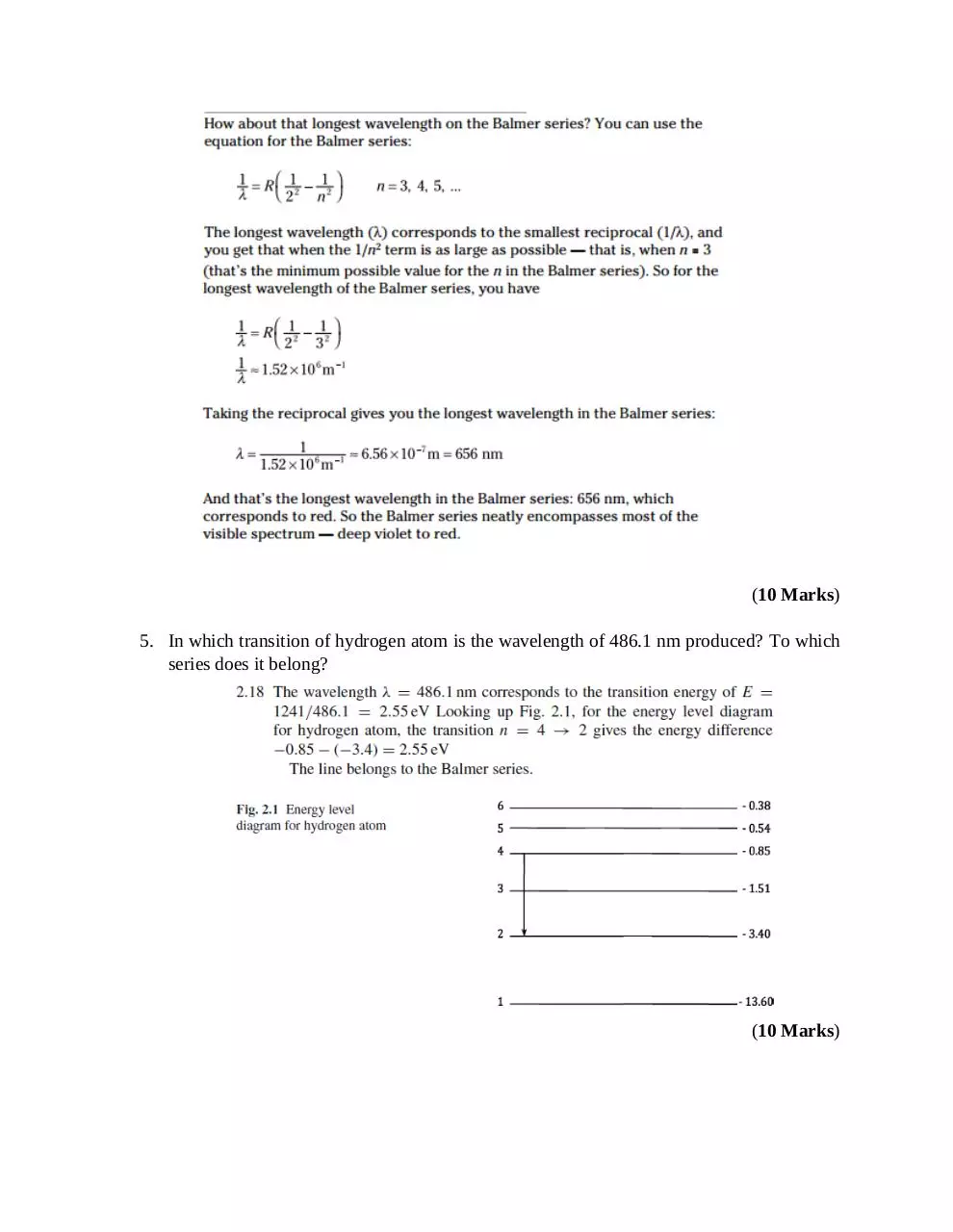Tutorial 5 QnA (003) (PDF)
File information
Author: Suhana Arshad
This PDF 1.5 document has been generated by Microsoft® Word 2013, and has been sent on pdf-archive.com on 19/05/2017 at 03:22, from IP address 202.170.x.x.
The current document download page has been viewed 1028 times.
File size: 573 KB (8 pages).
Privacy: public file





File preview
TUTORIAL 5: The atomic model
Submission deadline: 15th May 2017
1. With aid of a diagram, state the:
(a) Thomson Plum Pudding Model
(b) Rutherford Atomic Model
(c) Success and failure of both models
Solution:
An atom consists of Z electrons is embedded in a cloud of positive charges that exactly neutralise
that of the electrons’. The positive cloud is heavy and comprising most of the atom’s mass. Inside
a stable atom, the electrons sit at their respective equilibrium position where the attraction of the
positive cloud on the electrons balances the electron’s mutual repulsion.
Rutherford shots some alpha particles (which are really just the nucleus of a helium atom) at
some really thin gold foil. Rutherford found that most of alpha went right through the foil and
some of them did bounce back. Rutherford’s experiment prompted a change in the atomic
model. Based on his experimental evidence:
o The atom is mostly empty space
o All the positive charge, and almost all the mass is concentrated in a small area in the center.
o He called this a “nucleus”
o The nucleus is composed of protons and neutrons
o The electrons distributed around the nucleus and occupy most of the volume
o His model was called a “nuclear model”
The large deflection of alpha particle as seen in the scattering experiment with a thin gold foil
must be produced by a close encounter between the alpha particle and a very small but massive
kernel inside the atom. In contrast, a diffused distribution of the positive charge as assumed in
plum-pudding model cannot do the job. Plum-pudding model by Thompson, it fails to explain
the emission and absorption line spectrum from atoms because it predicts only a single
emission frequency. Most importantly it fails to explain the back-scattering of alpha particle
seen in Rutherford’s scattering experiment because the model predicts only.
According to classical EM, the Rutherford model for atom (a classical model) has a fatal flaw:
it predicts the collapse of the atom within 10-10 s. An accelerated electron will radiate EM
radiation, hence causing the orbiting electron to loss energy and consequently spiral inward
and impact on the nucleus. The Rutherford model also cannot explain the pattern of discrete
spectral lines as the radiation predicted by Rutherford model is a continuous burst.
(30 Marks)
2. Find the wavelength for the third, fourth, and fifth lines of the Layman series of hydrogen
(10 Marks)
3. At n = 7, an electron in a hydrogen atom makes six successive quantum jumps as it cascades
downward through every lower energy level. Find the wavelength of each of the six
photons emitted.
(20 Marks)
4. What is the:
(a) Shortest wavelength in the visible series of the Balmer series?
(b) Longest wavelength in the visible series of the Balmer series?
(10 Marks)
5. In which transition of hydrogen atom is the wavelength of 486.1 nm produced? To which
series does it belong?
(10 Marks)
6. A hydrogen-like ion has the wavelength difference between the first lines of the Balmer
and Lyman series equal to 16.58 nm. What ion is it?
(10 Marks)
7. The emission spectrum of hydrogen consists of several series of sharp emission lines in the
ultraviolet (Lyman series) in the visible (Balmer series) and in the infrared (Paschen series,
Brackett series, etc.) regions of the spectrum.
(a)
What feature of the electronic energies of the hydrogen atom explains why the
emission spectrum consists of discrete wavelength rather than a continuum
wavelength?
(b)
Account for the existence of several series of lines in the spectrum. What quantity
distinguishes one series of lines from another?
(c)
Draw an electronic energy level diagram for the hydrogen atom and indicate on it
the transition corresponding to the line of lowest frequency in the Balmer series.
(d)
What is the difference between an emission spectrum and an absorption spectrum?
Explain why the absorption spectrum of atomic hydrogen at room temperature has
only the lines of the Lyman series.
Answer:
(a)
Any of the following:
Quantized energy levels. Discrete energies.
Wave properties of electron result in discrete energy state.
(b)
An electron in an excited-state atom can go to any of several lower energy states.
The lines in each series represents shifts from several higher energy states to a
single lower energy state, identified by the same principal quantum number or
energy.
(c)
(d)
Emission spectra obtained when electrons in excited atoms drop to lower energy
levels. Absorption spectra obtained when electrons in atoms in ground (or lower
energy) state absorb electromagnetic radiation and move to higher energy states. H
atoms at 25°C are in lowest electronic energy state (n = 1) and so the only
absorptions will result from electrons moving from n = 1 to higher levels.
(10 Marks)
Download Tutorial 5 QnA (003)
Tutorial 5_QnA (003).pdf (PDF, 573 KB)
Download PDF
Share this file on social networks
Link to this page
Permanent link
Use the permanent link to the download page to share your document on Facebook, Twitter, LinkedIn, or directly with a contact by e-Mail, Messenger, Whatsapp, Line..
Short link
Use the short link to share your document on Twitter or by text message (SMS)
HTML Code
Copy the following HTML code to share your document on a Website or Blog
QR Code to this page

This file has been shared publicly by a user of PDF Archive.
Document ID: 0000598977.